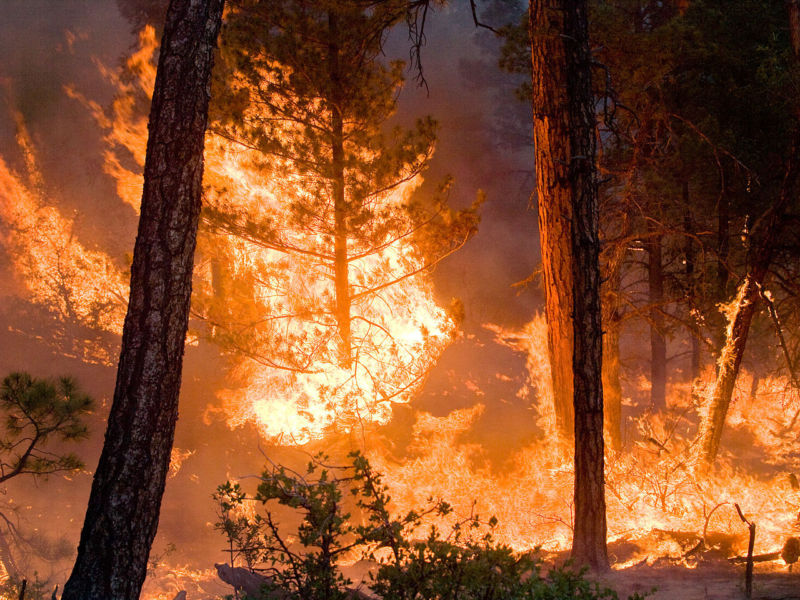
We tend to use "ice age" to mean a period where large ice sheets push south to what are now temperate regions. But from a geologist's perspective, even current conditions are part of an ice age, since large ice sheets exist at the poles. The term provides a contrast to what are called hothouse conditions, which the Earth has experienced for periods that were long enough to entirely melt the poles. The planet hasn't seen hothouse conditions for more than 2.5 million years.
But this week, headlines were full of discussion of a possible return of a hothouse Earth courtesy of climate change. The sudden worries weren't the product of any new research; instead, they were simply the product of a perspective some researchers had written on our current understanding of the climate, plus some potential risks associated with it. The perspective argued that there are multiple tipping points in the climate, and we can't rule out shooting past them even if we get emissions under control within a few decades.
Hot hot hot
So how seriously should we view this risk, and why are scientists suddenly talking about it now?
The perspective that set all of this off was written by a large group of Earth scientists, many of them European, and their work was published in the journal PNAS. Perspectives, rather than focusing on new or specific research findings, typically provide a broad overview of what we know about some aspect of a field of research. In this case, the focus was on possible trajectories for our future climate as human carbon emissions become an ever-growing driver of the climate's trajectory.
The authors point out that, for the last few million years, the Earth has cycled between a heavily glaciated state and one in which the ice has been largely limited to the poles. The details of these warmer periods vary—carbon levels and orbital influences differed, leading to differences in temperatures, the loss of ice, and resulting sea levels. But the differences were never large enough to drive the climate into a new state. When the orbital influences cycled back, the planet returned to a glacial state.
That's no longer the case. Even at current levels of carbon dioxide in the atmosphere, it would take something exceptional to allow glacial conditions to return, and emissions are set to push those levels up ever higher over the next few decades. And, if we're no longer in a situation where the Earth can cycle between two relatively stable states, it's reasonable to ask what the planet will do instead. Based on its past history, a hothouse state would seemingly be one possibility. The problem is that we don't know enough about what triggered historic hothouses to fully appreciate what could drive us into a new one.
The authors posit that a possible route to a hothouse would involve a combination of multiple tipping points, situations where a small amount of warming pushes parts of the Earth system into a change that's effectively irreversible, at least on any time scale that might be relevant to us. We may already be passing some tipping points, even at the relatively minor levels of warming we've experienced so far, so this isn't entirely hypothetical.
Feedbacks
The concern is that some of these tipping points feed back into the climate. An example would be the thawing of large areas of permafrost, which could release the carbon stored in them. Another option would be if warming destabilized the methane-water ices found in the ocean, which could allow the methane to reach the atmosphere. These are potential products of continued warming, and the carbon they'd dump into the atmosphere would in turn make further warming inevitable. In essence, the perspective is arguing that tipping points like these raise the prospect that relatively small changes could determine which future states our climate occupies—possibly something like a warmer present but potentially a far warmer hothouse.
The aspect of this perspective that ended up grabbing headlines is that the authors raise the prospect that we could already be on the path to a hothouse scenario, even if we were to limit our carbon emissions sufficiently to hold warming to about 2°C. If 2°C is enough to push us past a few tipping points, and those drive enough additional warming to push us past more, the climate could end up sliding downhill into a hothouse state even as we continued to cut emissions. The authors use this risk to argue that we should be very careful to recognize tipping points as we pass them and be prepared to make major interventions in the Earth's climate and ecosystems in order to keep things from going down this sort of path.
It's critical at this point to drive home that we don't have strong indications that we are on one of these paths or even that a hothouse state is accessible directly from our current climate. The perspective is closer to what you might call informed speculation. The presence of tipping points and feedbacks in the climate is well established, as is the history of times where the Earth experienced hothouse climates. The links among these, while plausible, haven't been established.
Is it appropriate for scientists to highlight risks like these? It could certainly be argued that they'd be irresponsible if they didn't. But the public often has a hard time understanding risks, as well as the scientific understanding behind them. In cases like this, where there's lots of media coverage (of mixed quality), then it's also irresponsible for the scientists to sit back and let the misunderstandings persist.
PNAS, 2017. DOI: 10.1073/pnas.1810141115 (About DOIs).
reader comments
301